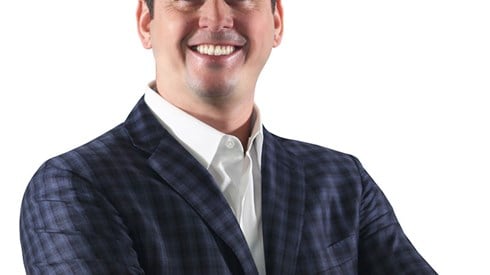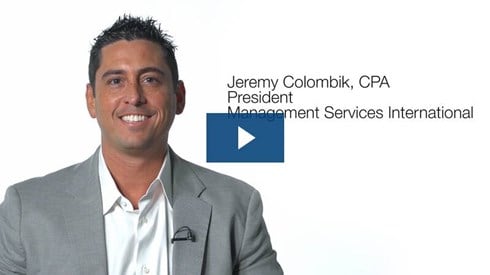Jeremy Colombik: Captive Insurance Person of Interest

October 06, 2017

As part of our ongoing commitment to provide thoughtful commentary concerning issues impacting captives and the broader insurance markets, we spoke with Jeremy Colombik, president of Management Services International (MSI). MSI currently manages more than 100 businesses that are utilizing a captive insurance company structure. MSI specializes in Internal Revenue Code § 831(b) captives.
It appears you started your professional career as an accountant and then obtained your CPA. Is that correct?
That's actually not correct. I started off as a life insurance agent and decided that I wanted to increase my tax knowledge and went back to school to obtain more accounting and taxation background. I also wanted to accumulate enough hours to sit for and pass the Certified Public Accountant (CPA) exam. However, prior to taking the CPA exam, I was already licensed and doing life insurance sales and was also working in the captive insurance industry.
How, exactly, did you get into captive insurance, then?
Well, I got into captive insurance when I was selling life insurance. My father, Richard Colombik, who is a well-known tax lawyer, introduced me to captives. My father mentioned that this could potentially be a great solution for some of my clients, and I eventually developed a niche in my area of focus. I have always enjoyed taking a complicated subject and making it simple and straightforward for my clients. Captives can be complex, but once you understand the benefits, it becomes clear that captives are a great business solution if done for the right purpose.
How did the idea come to you to form Management Services International?
Management Services International was formed 10 years ago as I was learning about captives from my father. At the time, I became intrigued about how a captive program can be developed in many different ways. Not all captive programs are the same. Based on this, I saw a tremendous need for many small to medium-sized business owners grossing $1 million to $250 million to make their risk management profitable. MSI's trademark is Risk Management Made ProfitableTM.
As I gained more knowledge and as years passed, my father approached me about a few of his clients that owned captives and asked if I would be interested in managing their captives. With my existing clients and the referral clients, I formed Management Services International in 2007. The company began with just of a handful of clients, maybe 5 or 10. Fast-forward to today, 10 years later, we have hundreds of clients with more than 10 company team members, and we continue to grow.
It appears that MSI specializes in 831(b) captives. Is that true? And, if so, why are you focusing on the micro-captives?
That is true. We do have some clients that are in the 831(a) markets, but most are in 831(b)s. The reason we initially did and still do focus on 831(b)s is, it seemed to me when I started my career, that the small to medium-sized business owners were underserviced. There are many more small to medium-sized companies than there are bigger "types" of companies. I viewed it as a great business opportunity to serve these underserviced clients and bring them this solution, which they were probably not aware of, and show them how it could really benefit their business.
Do you see the Avrahami v. Commissioner case as an aberration? Should owners of 831(b) captives be concerned by the ruling?
I don't view the Avrahami ruling as something that was unforeseen in the captive industry. Avrahami's outcome, in my personal view and also of many others in the industry, was not surprising. The Avrahamis' insurance company, unfortunately, was not operating as an insurance company and therefore was not entitled to insurance company taxation or other benefits.
Should owners of 831(b) captives be concerned?
Captive owners should take this case as a lesson on what not to do when operating an insurance company. At MSI, we have great relationships with our clients and promote healthy communication with them. When the ruling came out, we sent an e-mail to our clients explaining the ruling and articulated to them why their captives are substantially different. We also put the case in perspective for them by clarifying how the Avrahamis' captive was run and operated. The case ruling highlighted some blueprint steps that were not followed, and thus 831(b) owners can use this case to review their captive program to see whether it has some of these attributes. If captive owners are concerned, they should talk with their captive managers and really question if they're in the right program. In my opinion, and drawing from the lessons I learned from the case, if you want to manage a captive incorrectly, this case serves as a great example.
Considering the Avrahami ruling, do you think that it will have any impact on the growth of 831(b) captives?
I think it may, because it was a negative ruling and the Internal Revenue Service (IRS) will use this to put pressure on the captive industry. The industry, with Notice 2016–66 as well as the IRS limelight, so to speak, is focused on the 831(b)s and has, I believe, deterred some businesses from moving ahead due to the risk factor of a potential IRS audit. [Editor’s Note: IRS Notice 2016–66 identifies micro-captive insurance as a transaction of interest and requires disclosure by taxpayers.]
You are active in a number of captive associations. What do you believe are the most important needs these groups should be focusing on?
Right now, it seems the associations across the United States are focused on Notice 2016–66, how burdensome it is, and trying to get the notice rescinded. We do know that a lot of associations are working together to, hopefully, get this notice rescinded or repealed. Also, I believe we should focus on education. It's important to be able to educate lawyers, CPAs, and other advisers on what captives are and how they can be a great solution for business owners if they are done for the right purposes.
How would you suggest that the captive industry recruit new and younger talent?
Getting the right talent for our specific industry is a growing challenge. Our more seasoned employers and professionals are training the younger talent on how things should be done and handled properly to continue growth. Also, just like any industry that is seeking talent, word of mouth can help spread the message that our industry is looking to hire qualified people.
Besides 831(b) captives, where do you see growth in the captive industry coming from?
I would say workers compensation, business interruption due to the hurricanes and continued weather concerns, and medical stop loss coverage.
How do you stay current on the issues in the captive industry?
I attend conferences and communicate with colleagues, as well as read and analyze new IRS, court, and other rulings or pronouncements. I also attend association meetings, continue my education, and rely on other types of captive forums that provide up-to-date information, like Captive.com.
Do you have any other thoughts or observations that you would like to share concerning captives?
Even though captives have been getting some recent negative press, unfortunately, bad apples are in every industry, but captives are a great solution to a specific problem. If done for the right purposes, they can be an invaluable solution for a lot of business owners. I believe with more education and with more captive professionals explaining the right reasons for doing captives, and knowing all the benefits a business can obtain, that these bad apples will get out and the captive industry and captive owners will continue to flourish.
October 06, 2017

